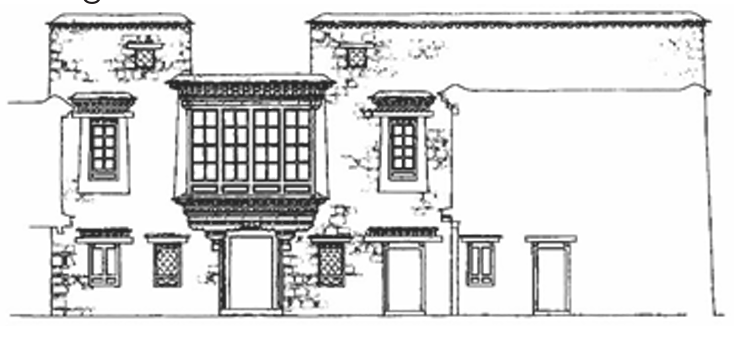ARCHITECTURE OF TIBETAN PLATEAU
1/53
There's no tags or description
Looks like no tags are added yet.
Name | Mastery | Learn | Test | Matching | Spaced |
|---|
No study sessions yet.
54 Terms
Buddhist Expansion
Result of what happened to India
Religion
has a big impact on Buddhist Expansion
Tibetan Plateau
Formerly a country but is presently a mountainous region in China
Global Warming
A threat to Tibetan Architecture
Tropical
Climate in regions involved in Buddhist Expansion (Tibet, Burma-Myanmar, Siam-Thailand, Vietnam, Laos, Indonesia, and Malay Peninsula) wherein South-west monsoon rains occur in Summer
Tibetan Plateau
Currently the Tibet Autonomous Region of China
China
Colonized Tibet in the 1950s
highest plateau
The Tibetan Plateau sits on the ________ in the world at the highest point of 4,500 meters
Tibet
Their high plains, forests and mountains form a unique ecosystem on the planet and are home to an array of rare wildlife, including the snow leopard, blue sheep and Tibetan wild ass
Tibet
encompasses Indian, Nepalist, and Chinese Architecture
India
South-west of Tibet
Nepal and Bhutan
South of Tibet
China
North-east of Tibet
Indian Art
11th-14th century stylistic sources of Tibet’s Art and Architecture
Nepalese Art
14th-16th century stylistic sources of Tibet’s Art and Architecture
Chinese Ming Schools
15th Century to present stylistic sources of Tibet’s Art and Architecture
Permafrost
Tibet’s geology; a permanently frozen soil, sediment, or rock, solely based on temperature, not moisture or ground cover.
two
In permafrost, the ground must remain at or below 0°C for at least ____ years.
Stone, Clay, and Wood
Natural materials from Tibetan Architecture
China
The People’s Republic of _______ prohibits the practice of religion in Tibet.
Buddhism
What religion constitutes the majority of the population in Tibet?
King Trisong Detsen
Religion was introduced in Tibet towards the end of the 8th century when _________, invited two Buddhist masters from India.
Mahayanist
Tibetan Buddhism combined the original, or _________ practices with yoga, tantra, shamanic rituals and elements of an older Tibetan religion known as Bon.
Dalai Lama
The principal spiritual leader of Tibetan Buddhism
Tenzin Gyatso
14th Dalai Lama of Tibet
Government
Since the 5th Dalai Lama, headed the Tibetan ___________
India
Dalai Lama is currently in exile in ________ due to China’s annexation of Tibet.
Lungta
Mythical wind horses, and prayer flags
Organic Design and Natural Materials
Architectural Character of Tibet
Organic Design
Design that compliments the natural surroundings
Buildings appear to grow out of the landscape
Symmetrical
Character of Tibet’s Plan (lay-out and façade design)
stone or rammed earth
Tibetan Architecture uses _________ up to a meter thick at the base.
trapezoidal form
Temples and manor houses in Tibetan Architecture are slightly __________, heavy at the bottom (stone foundations) and light at the top, generally with battered walls
small
Tibetan windows are usually _____ because the walls are so heavy that large openings would make the structure weak and unstable.
glass
Tibetan openings used paper-covered wooden latticework then but was replaced by _______.
Detailed code
Tibetan Architecture uses _______ for the decoration of doors, windows and parapets (including Painted black frames around doors and windows, and complex wooden overhang decorations)
Flat roofs with parapets
Roofs in central and western Tibetan plateau with seldom rain.

Sloping roofs
Tibet uses ________ covered either in slate, shingles, or ceramic tile.
timber frame
Tibetan columns use intricately carved interior _______ following standardized design principles.
Talismans
Tibet uses _______ on roof as guardians.
Chorten
Eight different kind stupas, all referring to major events in Buddha Shakyamuni’s life
Potala Palace
(of Tibet) comprised of an outer white palace and the red quarters
Outer White Palace
(of Potala Palace in Tibet) houses the administrative quarters-Inner
Red Quarters
(of Potala Palace in Tibet) houses the assembly hall of the Lamas, chapels, 10,000 shrines and a vast library of Buddhist scriptures.
Jokhang
1st Buddhist temple in Tibet, located on Barkhor Square in Lhasa.
King Songsten Gampo
Johang was built during the reign of _________ (605-650 CE) to celebrate his marriage with Chinese Tang Dynasty princess Wencheng, who was said to have introduced Buddhism to Tibet.
Tsulag Khang, House of Wisdom
Jokhang in Tibet was called the ________ or “_________‘’ but it is now known as the Jokhang which means the ‘House of the Buddha’
Jokhang, House of the Buddha
A temple in Tibet was formerly known as the Tsulag Khang or ‘House of Wisdom’ but it is now known as the _______ which means the ‘_________’
Heavenly Jokhang
Talisman guarding the rooftop of Jokhang, the most revered religious icon of Tibet where hundreds of prostrating pilgrims gathers everyday
Tashi Lhunpo Monastery
Best preserved monastery in Tibet
Tagong Temple
It’s a symbol of the cultural mixture of the nations in China at that time and is one of the most important temples in Tibet.
Tibet and China
Tagong Temple combines the architecture style from both ______ and _______.
High Golden Tower
The Tagong Temple is the __________ which is a symbol of Tibetan temple while edge of the roof resembles Han Chinese style.
Chorten
Tibet’s ‘Stupa’